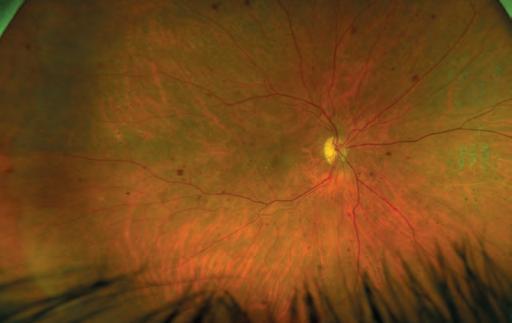
3 minute read
How can OCT scans support patients with diabetes?
by TheAOP
The number of people living with diabetes is thought to have topped five million for the first time this year, analysis by Diabetes UK found.
Routine eye examinations form a core part of managing the condition, and optical coherence tomography (OCT) can be a tool in the optometrist’s belt for observing changes and providing reassurance.
Advertisement
A holistic view
The diabetic eye screening programme began in England in 2003, reaching national coverage in 2008, and while it is important that patients participate, ensuring they maintain routine eye tests is crucial.
Sharon Ormonde, Optos sales director for Northern Europe, told OT: “Optometrists often tell us that patients who live with diabetes may decline enhanced tests (such as combined OCT and ultra-widefield imaging) on the basis that they have already undergone their diabetic screening, assuming this includes a thorough assessment of eye health.”
Integrating OCT into routine sight testing in practice can help to provide a more complete picture, with optometrists seeking a more holistic view of the eye.
Ormonde shared: “Optometrists frequently find themselves explaining this distinction to patients in their clinics.”
As a potential aid supporting early diagnosis, scans could provide reassurance.
Ormonde highlighted: “If a patient has a fundus image and an OCT, the optometrist can show them the back of the eye and explain what they are looking for. This offers all patients a peace of mind that they have had the most thorough review of their eye health possible (whether or not they are living with diabetes).”
Clinical confidence
Claire Martin, head of strategy and marketing for ophthalmic diagnostics for Zeiss, emphasised that screening services “only take a basic visual acuity, without IOP or a slit lamp examination, and rarely include an OCT scan.”
Modern OCT technology is able to diagnose diabetic macular oedema (DME) with a high level of accuracy, Martin shared, using “near micron accurate, threedimensional measurements of the retina.”
For patients receiving a sight test in practice, Martin said: “All published studies have agreed that completing a separate OCT alongside colour fundus gives the best results for early detection of diabetic retinopathy,” adding that 3D OCT scans provide the most accurate result for DME alongside the annual diabetic eye screening. Using OCT in routine appointments can support the detection of other conditions, such as glaucoma or AMD. In addition, tools like the Cirrus 6000 offer a wellbeing report with an overview of the retina and RNFL, which could be taken to the next screening.
An educational tool
Emmeline Webb, clinical sales specialist for Heidelberg Engineering, said: “Having an OCT available during a routine sight test would benefit the patient by offering early reassurance or diagnosis regarding any ophthalmic concerns caused by diabetes.
“Images could also be used as a visual tool for the patient, helping them to understand how their diabetes can be affecting them as an individual.”
A variety of factors can affect an individual’s care, Webb said: “Offering more information and advice to the patient could allow them to feel more confident regarding the management of their diabetes, which could help to improve their overall mental health and wellbeing.”
Using fundus photography and OCT images as a teaching tool can support a patient’s knowledge of their condition, and “this also helps them understand how they are being affected directly, as they can see visual changes.”

Shared care
Manufacturers highlighted the drive to see more patient care delivered closer to home.
“There is a drive to shift patient care increasingly towards community settings,” Ormonde said.
Initiatives vary across healthcare systems, but technology can provide the information needed to help detect changes earlier, enable timely interventions, and improve outcomes.
Zeiss’ Martin noted that patients can fall between the screening service and hospital eye service: “not needing treatment but needing more advanced and accurate images taken than two-dimensional colour fundus.”
“Community optometry with OCT diagnostics will be able to test and review patients that need repeatable OCT to confirm whether the patient’s diabetic retinopathy is stable or improving with the ability to quickly refer patients back to the hospital eye services when needed,” Martin added.
Elizabeth Woodstock, clinical sales specialist for Heidelberg Engineering, commented: “Building a strong relationship between primary and secondary care can be a beneficial solution for both parties, ultimately improving the accessibility of timely care for patients with various eye disease.”
“Moving forward, I anticipate that the role of OCT imaging will continue to expand in community optometry, with an OCT device being an invaluable asset to any practice,” she concluded.









